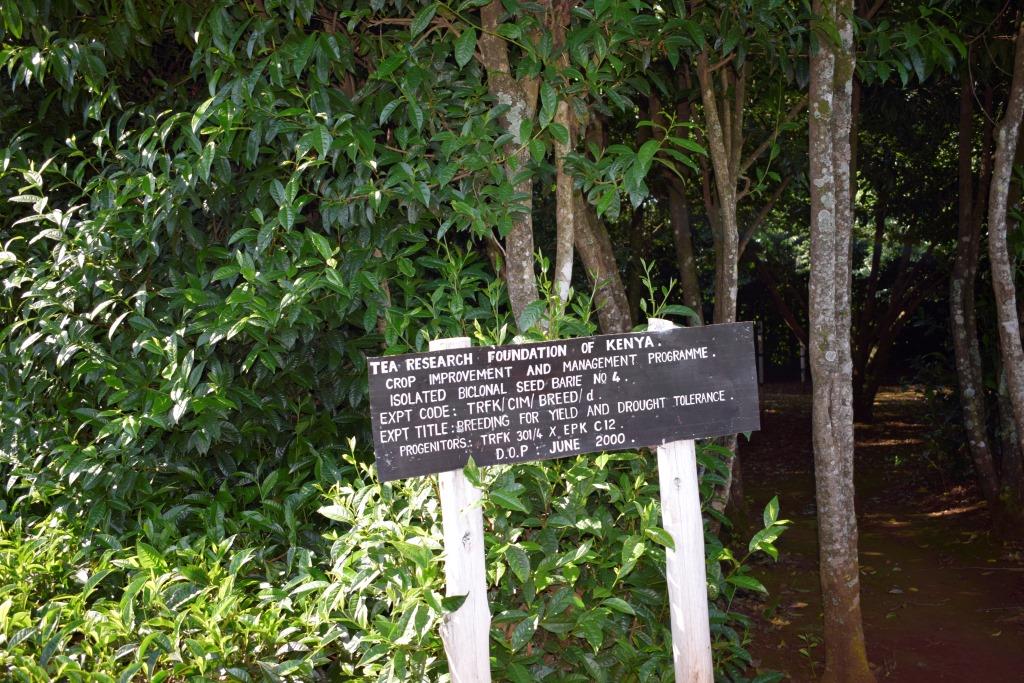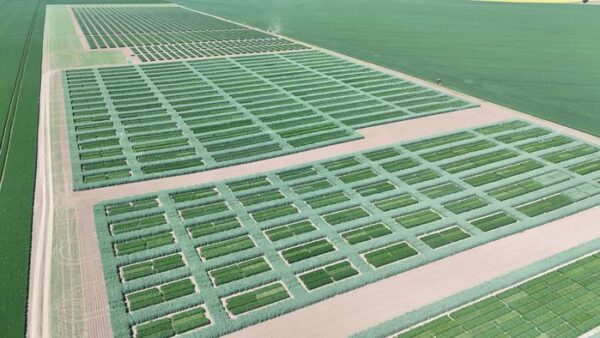Tea plants are native to East Asia, and probably originated in the borderlands of north Burma and southwestern China. By annual per capita consumption of tea, the countries with the highest consumption are Northern Ireland (6.9 kg), Ireland (2.19kg) and United Kingdom (1.94kg).After China and India, Kenya is the largest tea producer in the world, with an annual production of 0.5 million tonnes. The crop was first introduced in Kenya in 1903, and first commercialization started in 1924. Since then the country has become a major producer of black tea and the crop is a major cash crop for Kenya. Kenyan tea has been the leading major foreign exchange earner for the country. Most tea produced in Kenya is black tea, with green tea, yellow tea, and white tea produced on order by major tea producers. There is a large diversity in tea varieties, the UPOV PLUTO database lists close to 1000 tea varieties. All the more reason to look into interesting crop. So European Seedsat down with Dr. Samson Kamunya, Chief Research Officer and Dr. Richard Chalo, geneticist at the Tea Research Institute in Kericho, Kenya to learn more about what it takes to develop new tea varieties.
ES: Tea is nowadays a vegetatively propagated crop. How does tea breeding compare to the breeding of a seed propagated crop?
Samson Kamunya (SK): The pioneer tea plantations were established using seedling tea plants comprising of mixed random collections from India and Sri Lanka. As these seedling populations comprised unique genotypes, uniformity in yields and tea quality could not be established, in addition to maintenance of good leaf picking table. This resulted in visual selection, on basis of general vigour, plucking point density and large shoot size, of elite bushes for vegetative propagation and commercialization. Thus, the only difference between seedling tea and vegetatively propagated tea fields is only in propagation. The mode of breeding is the same, only that current breeding efforts entail use of parents with known disparate attributes, and once seedling plants are fully established and evaluated for one pruning cycle consisting of four years, the best performing bushes are cloned by collecting cuttings from them and advanced to clonal field trials (CFT). The CFTs are evaluated for two pruning cycles (at least 8 years) with the best clones in terms of high yields and black/green tea quality are released to farmers for commercial utilization. Pictorial presentation of tea breeding scheme at the TRI is presented above.
ES:What are the most important breeding goals in your tea breeding program?
Richard Chalo (RC): The current glut of black tea in world market in the face of increased cost of production has resulted into dwindling revenue base from tea enterprise. As it has been projected that the market for black CTC tea will decline, while that for specialty tea will increase in the next 10 years, our primary focus is to develop tea varieties that are suitable for novel specialty tea products. Thus, availability of the requisite raw material for diversification of tea products is being given serious consideration for the Kenyan tea business to remain relevant.
ES: Tea is attacked by over one hundred diseases, such as several blights, cankers, root rot and many others. Which diseases are most important and where do you find the genetic diversity for the resistances?
SK: The most important disease is Armillaria root rotand Hypoxylonwood rot. The greatest diversity for genetic resistance is however found within seedling populations as each plant is a distinct genotype. In Kenya, these diseases are a major problem so long as growers prepare their lands properly during planting and practice good agricultural practices during the lifetime of the tea crop.
ES:Do you breed for tolerance to abiotic stress (e.g. drought)?If so, which stresses?
RC: Due to global climatic changes, the frequency, longevity and severity of drought have increased especially in the traditional tea growing areas. Similarly, stress associated with low temperatures as well as high soil pH have been noted to be serious constraints to tea production in some parts of the west of Rift Valley. Additionally, tea farming is increasingly being extended into the non-traditional tea-growing areas that were formerly considered marginal, highly variable and therefore unsuitable for the crop. Therefore, a need has arisen for consolidation of inherent breeding for tolerance to drought in the tea plant is imperative for sustainable tea production on adoption of climate-compatible clones.
ES:Do you focus on improved nutritional and health characteristicsin your new tea varieties, and how easy or difficult is it to increase these levels?

SK: The tea plant has recently received a lot of attention due to its medicinal properties. Its pharmacological potential is widely acknowledged and is ascribed to flavonoids particularly catechins. Furthermore, certain tea catechins (i.e. EGCG) have been associated with boosting the body’s immunity and to exhibit anti-cancer properties. Other useful chemicals found in tea such as polyphenols (flavanols and anthocyanins) also have antioxidant properties and so help in combating chronic diseases like cancer as well as cardiovascular diseases. Other prophylactic properties of tea are also attributed to caffeine, anthocyanins, carotenoids, and theobromine found in young flush shoots of tea. Kenyan tea varieties have some of the highest levels of these biomolecules among all the tea growing countries. However, these levels appear to be reaching a plateau as can be exhibited by newly developed populations. The prolonged breeding cycle and perenniality of the tea plant are big hindrances to accelerated improvement.
ES: You have recently developed a new tea variety with high levels of anthocyanin in the leaves and a reddish-brown leaf colour. It is marketed as ‘purple’ tea. What is so special about this new variety?
RC: The purple tea variety was officially released for commercial use vide Gazette Notice No. 9231 of 29thJuly 2011 as per the requirements of the “The Seeds and Plant Varieties Act (Cap 326)”. Prior to its gazettement, the variety had successfully undergone the various stages of evaluation right from breeding, progeny testing, clonal field testing, clonal adaptability trials by TRFK plant breeding team and regulatory evaluations by the Plant Variety Protection (PVP) office of Kenya Plant Health Plant Inspectorate Service (KEPHIS) entailing distinctness, uniformity and stability (DUS) testing to Variety Release Committee Examination (chaired by Agriculture Secretary, MoA), a period that spanned nearly 30 years. The variety is an inter-specific hybrid between a tea plant, Camellia sinensis(L.) Kuntze and non-tea plant, namely Camellia irrawadiensis(Hu) P.K. Barua,rich in anthocyanins. Other purple tea varieties/clones mainly with Chinary (small-leaved and shrubby) characteristics also exist in TRI tea improvement programme but they are generally poor yielding with tiny shoots owing to which they are disliked by tea pickers (major desirable attributes that are considered by growers include heavy and easy to pluck shoots).
ES: Creating diversity for your growers and customers is of crucial importance for any breeder. Where do you go to find the necessary germplasm that will help you in your breeding work? What are the main sources of your diversity: mainly commercial varieties, or also landraces and other species?
SK: Progress in plant improvement programmes is dependent on the extent of genetic diversity within the available genetic stocks. TRI has collected and conserved several tea germplasm. This collection includes landraces, popular commercial cultivars, wild teas and non-tea related species. Further, the institute has introduced cultivars with unique traits to its collection by entering into germplasm exchange agreement with other tea producing countries.
ES: Do you find that you have sufficient access to new germplasm, or has this been made more difficult because of the new regulations on access and benefit sharing?
RC: There has been limitation to accessing new germplasm which is attributed to the new regulations on access and benefit sharing of plant genetic resources.
ES: Which kind of investments in time and money (on average and rough estimates) does it take to develop a new tea variety?
SK: Being a perennial crop, it takes over 20 year to develop a new tea variety. During the period of selection, enormous resources are utilized.
ES: How does your organization make sure that your future products are aligned with what the growers and consumers want?
RC: Research at the institute is guided by a Research and Advisory Committee, comprising tea industry stakeholders. The committee is composed of representatives from the entire tea industry who play a key role in developing the TRI research agenda.
ES: What is the biggest challenge for a breeder when developing a new tea variety?
SK: A major challenge to tea breeders in Kenya is climate change. It is predicted that the main tea growing areas will experience an increase in the length of dry seasons per year, warmer temperatures and/or extreme rainfall intensity. The phenomenon is further complicated by the fact that drought stress might accompany heat and/or salt stress depending upon the severity of the drought stress and the environmental conditions including soil type. Under such circumstances, world tea production is clearly vulnerable to the predicted drought and climate change effects, and subsequently greater economic, social, and environmental problems. These necessitate intense research to improve tea production under diverse stress conditions. Further, financial resource to carry out research is limiting bearing in mind the Kenyan tea industry has stopped funding research through the tea levy.
ES: What are the innovations (technological, genetic, molecular etc.) which are in the pipeline in tea breeding?

RC:In an effort to shorten the breeding time, the institute has adopted molecular biology approaches in breeding. Recent advances in both genetic and genomic technologies provide opportunities to develop millions of novel markers in tea, as well as identify genes of agronomic importance that permits an understanding of how important agronomic traits are controlled, knowledge of which can be directly translated into crop improvement.
ES: What kind of hurdles do you experience when breeding and commercializing a tea variety
SK: The institute is underfunded and therefore unable to adequately meet its research mandate.
What are Anthocyanins?
Anthocyanins are flavonoids which belong to a group of polyphenolic compounds that have a C6-C3-C6 configuration consisting of two aromatic rings linked by three carbons. The word anthocyanin is derived from two Greek words anthos, which means flower, and kyanos, which means dark blue, revealing their important characteristic as natural colorants. The anthocyanins absorb light intensely at visible wavelengths imparting colour such as orange, red, blue and purple to plant tissues including flowers, vegetables and fruits. As a result of their intense coloration, they are used as dyeing agents and food colorants, but the use of these natural colorants is limited due to their stability to pH, light and temperature. Industrially, they are important as natural food colourings since colour is the most important attributes of food that is appreciated for its intrinsic and aesthetic value and as a basis for identification and quality judgement. Attractive foods are sought as pleasure giving while unattractive foods are avoided.
Anthocyanins are glycosides (have glucose substitution) of different anthocyanidin aglycones (without glucose substitution) that naturally associate with other compounds. There are eighteen naturally occurring anthocyanins that have been discovered but among these, six are the most common. These are: i) cyanidin, ii) peonidin, iii) delphinidin, iv) petunidin, v) pelargonidin, and vi) malvidin. In plants, anthocyanins occur in glycosylated forms. They are linked to sugars such as glucose, galactose, arabinose, rhamnose, xylose and fructose. The berry nectars (grapes, bilberries and blueberries) are some of the richest source of anthocyanins. Other crops are purple cabbage, carrots, banana bracts, apples and many other edible fruits and vegetables. Recently, anthocyanins have also been introduced through interspecific hybridization in some Kenyan tea cultivars. Worldwide, the tea plant has received immense attention due to its proven pharmacological properties and moreover it is inexpensive and widely available. Tea contains polyphenolic compounds mainly catechins but of all the known catechins, EGCG has been found to be the most potent pharmacologically particularly in boosting immunity and curing cancer.
Health benefits of anthocyanins
Recent studies have shown that anthocyanins display a wide range of biological activities which include:
- Antioxidant
- Anti-inflammatory
- Antimicrobial
- Anticarcinogenic activities
- Induction of apoptosis in carcinogenic cells
- Protection of cells against oxidative stress induced apoptosis
- Improvement of vision
- Neuroprotective effects
- Variety of effects on blood vessels and platelets that may reduce the risk of coronary heart disease
Anthocyanins have been found to be highly reactive radical scavengers in vitro and apart from this, they also bind heavy metals such as Zinc, Iron and Copper thereby preventing formation of radicals that damage living cells and tissues in a process called “oxidative stressleading to occurrence of degenerative diseases.










